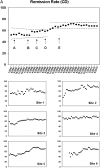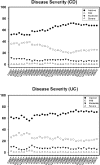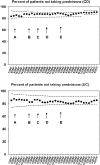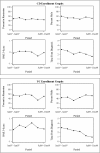Improved outcomes in a quality improvement collaborative for pediatric inflammatory bowel disease
- PMID: 22412030
- PMCID: PMC3313634
- DOI: 10.1542/peds.2011-1700
Improved outcomes in a quality improvement collaborative for pediatric inflammatory bowel disease
Abstract
Objectives: Unintended variation in the care of patients with Crohn disease (CD) and ulcerative colitis (UC) may prevent achievement of optimal outcomes. We sought to improve chronic care delivery and outcomes for children with inflammatory bowel disease by using network-based quality improvement methods.
Methods: By using a modified Breakthrough Series collaborative structure, 6 ImproveCareNow Network care centers tested changes in chronic illness care and collected data monthly. We used an interrupted time series design to evaluate the impact of these changes.
Results: Data were available for 843 children with CD and 345 with UC. Changes in care delivery were associated with an increase in the proportion of visits with complete disease classification, measurement of thiopurine methyltransferase (TPMT) before initiation of thiopurines, and patients receiving an initial thiopurine dose appropriate to their TPMT status. These were significant in both populations for all process variables (P < .01) except for measurement of TPMT in CD patients (P = .12). There were significant increases in the proportion of CD (55%-68%) and UC (61%-72%) patients with inactive disease. There was also a significant increase in the proportion of CD patients not taking prednisone (86%-90%). Participating centers varied in the success of achieving these changes.
Conclusions: Improvements in the outcomes of patients with CD and UC were associated with improvements in the process of chronic illness care. Variation in the success of implementing changes suggests the importance of overcoming organizational factors related to quality improvement success.
Figures






References
-
- Centers for Disease Control and Prevention. Chronic disease prevention and health promotion. Available at: www.cdc.gov/chronicdisease/overview/index.htm. Accessed January 19, 2010
-
- Centers for Disease Control and Prevention. Inflammatory bowel disease (IBD). Available at: www.cdc.gov/nccdphp/dach/ibd.htm. Accessed March 23, 2010
-
- Mackner LM, Sisson DP, Crandall WV. Review: psychosocial issues in pediatric inflammatory bowel disease. J Pediatr Psychol. 2004;29(4):243–257 - PubMed
-
- Gupta N, Cohen SA, Bostrom AG, et al. . Risk factors for initial surgery in pediatric patients with Crohn’s disease. Gastroenterology. 2006;130(4):1069–1077 - PubMed
-
- Boyle B, Mackner L, Ross C, Moses J, Kumar S, Crandall W. A single-center experience with methotrexate after thiopurine therapy in pediatric Crohn disease. J Pediatr Gastroenterol Nutr. 2010;51(6):714–717 - PubMed
Publication types
MeSH terms
Grants and funding
LinkOut - more resources
Full Text Sources
Other Literature Sources
Medical

